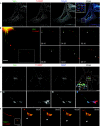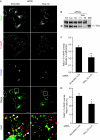Role of Varp, a Rab21 exchange factor and TI-VAMP/VAMP7 partner, in neurite growth
- PMID: 19745841
- PMCID: PMC2759737
- DOI: 10.1038/embor.2009.186
Role of Varp, a Rab21 exchange factor and TI-VAMP/VAMP7 partner, in neurite growth
Abstract
The vesicular soluble N-ethylmaleimide-sensitive factor attachment protein receptor (SNARE) tetanus neurotoxin-insensitive vesicle-associated membrane protein (TI-VAMP/VAMP7) was previously shown to mediate an exocytic pathway involved in neurite growth, but its regulation is still largely unknown. Here we show that TI-VAMP interacts with the Vps9 domain and ankyrin-repeat-containing protein (Varp), a guanine nucleotide exchange factor (GEF) of the small GTPase Rab21, through a specific domain herein called the interacting domain (ID). Varp, TI-VAMP and Rab21 co-localize in the perinuclear region of differentiating hippocampal neurons and transiently in transport vesicles in the shaft of neurites. Silencing the expression of Varp by RNA interference or expressing ID or a form of Varp deprived of its Vps9 domain impairs neurite growth. Furthermore, the mutant form of Rab21, defective in GTP hydrolysis, enhances neurite growth. We conclude that Varp is a positive regulator of neurite growth through both its GEF activity and its interaction with TI-VAMP.
Conflict of interest statement
The authors declare that they have no conflict of interest.
Figures





References
Publication types
MeSH terms
Substances
LinkOut - more resources
Full Text Sources
Molecular Biology Databases
Research Materials
Miscellaneous

